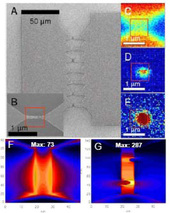Highlight
Probing Single Molecules Electrically and Optically at the Same Time
Achievement/Results
As electronics rapidly moves towards nanoscale devices there has been greater and greater interest in molecular electronics, that is, single molecules that can ultimately function as devices in nanoscale circuits. Major efforts have been pursued in the last decade in the development of such devices, and this progress has stimulated the need to interface and to probe the device behavior of these new types of molecules in circuitry. Significant challenges lay ahead in this field, which critically demand the development of methods to characterize the presence, orientation, electrical properties and performance of these new nanoscale devices.
Address Goals
In the Natelson lab at Rice University, our IGERT Fellow Daniel Ward has developed a new and critically important strategy for the characterization of molecular electronic devices. By combining molecular electronics techniques that interface single molecules electrically with optical methods to probe the same molecule, they are able to obtain electrical signals and optical signals from the same molecule for the first time. The optical method utilized is Surface Enhanced Raman Scattering, and the structures fabricated for this dual measurement system were specially designed to provide single molecule sensitivity for this method (see Figure). The structures in which the molecules are placed are called “nanogaps” and allow the molecules to be probed in this dual manner. In these measurements, optical blinking and color changes (what is known as spectral diffusion) are observed to correlate with changes in conductance. In the past both these types of signals have been presumed to indicate the presence of a single molecule but these experiments provide irrevocable evidence that this is the case.






